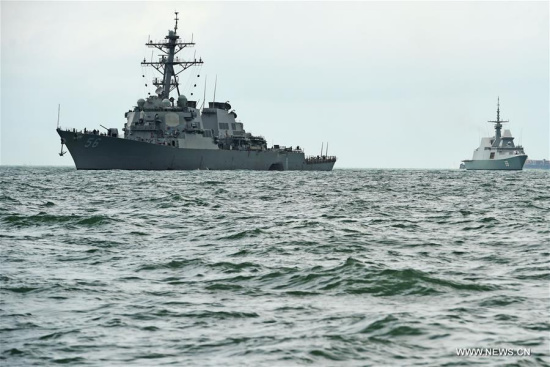 USS John S. McCain (L) is seen at sea off Singapore's Changi Naval Base, on Aug. 21, 2017. Ten sailors were missing and five others injured after the guided-missile destroyer USS John S. McCain collided with a merchant vessel in waters east of the Straits of Malacca and Singapore early on Monday, the U.S. navy said in a statement. (Xinhua/Then Chih Wey) A U.S. destroyer's collision with a merchant vessel east of Singapore on Monday, the fourth accident involving a U.S. warship this year, reveals problems of U.S. Navy training and calls into question the U.S. so-called "freedom of navigation operation" ("FONOPs"). The guided-missile destroyer USS John S. McCain collided with Greek tanker vessel Alnic MC in waters east of the Straits of Malacca and Singapore, leaving 10 sailors missing and five others injured. OPERATIONAL PAUSE The U.S. Navy announced Monday an operational pause of its fleets globally and a comprehensive review of the U.S. Pacific-based 7th Fleet after the collision, which caused significant damage to the destroyer's hull, resulting in flooding to crew berthing, machinery, communications rooms and other nearby compartments. The review should seek the root causes of the incidents, said U.S. Chief of Naval Operations Admiral John Richardson, in a video published on the U.S. Navy's official Twitter account. The investigation will examine the process by which the U.S. Navy trains and certifies its forces that were forward deployed in Japan, said Richardson, adding that the investigation team should be a "broad and diverse" one, with people inside and outside the Navy. The USS McCain is the fourth U.S. Navy ship involved in an accident this year. In January, the USS Antietam ran aground, dumping 1,100 gallons of hydraulic fluid into Tokyo Bay. On May 9, the guided-missile cruiser USS Lake Champlain was struck by a South Korean fishing vessel off the Korean Peninsula. In mid-June, the guided-missile destroyer USS Fitzgerald collided with the Philippine container vessel ACX Crystal, claiming the lives of seven Fitzgerald sailors, injuring three more and damaging both ships. "NAVY IS NOT LOOKING GOOD" The Straits of Malacca is a busy shipping lane with about 8,000 ships passing by daily. However, CNN military analyst Rick Francona believed that the McCain, with faster speed and better equipment, could have avoided the collision. "How does a state-of-the-art Navy destroyer -- equipped with multiple radar systems and communications gear with a full bridge watch -- not see, detect and evade a 30,000-ton slow-moving behemoth?" Francona asked. "I can almost guarantee you that there will be a tumultuous shake-up in the senior leadership of at least the 7th Fleet and maybe the Navy in general," Francona said. On Aug. 17, the U.S. 7th Fleet issued a statement, announcing the commanding officer, executive officer and command master chief of the Fitzgerald were relieved of their duties. They were believed to demonstrate "flawed watch stander teamwork and inadequate leadership," which contributed to the collision. "The Navy is not looking good about now," Francona said. "It's not the same level of training you used to get," American Fox News quoted an anonymous official as saying. INFLAMING REGIONAL TENSION On Aug. 10, the McCain illegally sailed within 12 nautical miles of the Meiji Reef of the Nansha Islands in the South China Sea and conducted a so-called "FONOP" without permission of the Chinese government. It was the third "freedom of navigation operation" during Donald Trump's presidency, as reported by Reuters. On July 2, the missile destroyer USS Stethem trespassed into China's territorial waters off the Xisha Islands. On May 25, the USS Dewey illegally sailed within 12 nautical miles of the Meiji Reef. As a country outside the South China Sea region, its navy sailed across the Pacific with aims to inflame regional tension and destroy regional peace and stability to profit from the disorder, Ling Xiaoyun, a critic of the Asia Pacific Daily, wrote in the paper. The United States will reap the bitter fruits of its disguised "freedom of navigation" in the South China Sea, where over 100,000 ships of various countries pass freely, as its naval maneuvers benefit none and might cause more collisions with merchant vessels, Ling said in his article. The Straits of Malacca, the main shipping channel between the Indian Ocean and the Pacific Ocean, is a more sensitive area than the South China Sea, he said. More collisions may occur if the U.S. Navy continues to conduct more "freedom of navigation" in this area, which may lead to a restriction of the freedom of merchant vessels, he said. The U.S. so-called "FONOPs" aim to uphold U.S. global maritime supremacy, and challenge other countries' sovereignty and international public interests, said Ling. |
Powered by Discuz! X3.4
© 2001-2013 Comsenz Inc.